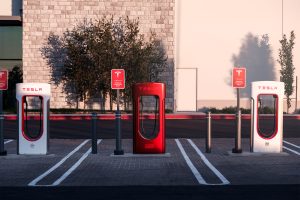During the Q2 2021 Earnings Call Update Letter released in late July, Tesla revealed that the Semi program would be delayed once again due to battery cell constraints and supply chain bottlenecks. However, developments regarding the Semi’s charging system still move forward, and one document from Ideanomics subsidiary WAVE proposes an extreme fast-charging system that would provide speeds of 500 kW and 1 MW. It would be void of cables, wires, and implanted directly into the roadway, providing power without having to plug in.
WAVE, an acronym for Wireless Advanced Vehicle Electrification, is owned by NASDAQ-listed company Ideanomics. WAVE develops high-power inductive charging solutions, but not for things like cell phones. They develop these charging systems for medium and heavy-duty vehicles, and the Tesla Semi may be one of the first vehicles to utilize the technology.
In the document, WAVE shares that extreme fast-charging systems are a sub-category of the company’s primary 250 kW business. However, it aims to develop 500 kW and 1 MW-capable wireless electric vehicle chargers for large-scale commercial vehicles using a primary coil embedded in the roadway and a receiving coil within the truck. Power would then be transferred using magnetic fields that are created by using a resonant inverter to create high-frequency AC currents to energize a charging coil. The energy from the coil underground would transmit energy to the truck, providing a charge without plugging in.

WAVE specifically mentions the strengths of the system and how it could benefit the Tesla Semi, in particular. The document states:
“The current state-of-the-art drayage truck charging features primarily conductive chargers. The recently announced Tesla Semi concept design has the largest advertised range of 500 miles with a target 80% charge in 30 minutes. The battery pack is estimated to be at least 800 kWh (likely much higher to cover full load and all conditions) and must have a target charge rate of at approximately 1.5 MW. The system under development via the US DOE contract of charging an electric drayage truck at extreme fast-charging power levels will be the fastest charger by a significant margin.”
This will be possible through WAVE’s recently-developed wireless charging system that can transfer up to 250 kW for bus charging at a distance of 250 millimeters, or 10 inches. “This is achieved by using a scalable modular approach. For this project, WAVE will increase the power level to 500 kW.”
WAVE can achieve the increased power level by increasing the power rating and density of the electronics and the coil design. Uses for the idea can be applied to “a number of urban applications,” and WAVE indicates that it won’t be a technology exclusive to Class 8 vehicles.
Tesla has been developing the Megacharger for the Semi for several years and has achieved some impressive specs ahead of the vehicle’s release. In 2017 at the Semi’s unveiling event, CEO Elon Musk said that Tesla would install a global network of solar-powered Megachargers that could provide 400 miles of range in just 30 minutes. An output of over 1 MW would make this possible, but to avoid potential dangers due to high energy output, Tesla filed for liquid-cooled charging connectors. Tesla uses something similar in its V3 Superchargers.
Yesterday, WAVE was awarded a contract to develop wireless inductive charging solutions by government organization Sourcewell.





